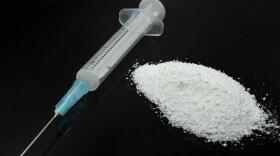This week, 20,000 Portage County children are taking home a resource guide aimed at fighting the addiction epidemic that has claimed nearly 200 lives in the county since 2012.
The guide was developed by the Record-Courier newspaper and features information about new efforts to treat addiction through a program developed at University Hospitals Portage Medical Center in Ravenna.

Renee Klaric is the manager of the medically assisted addiction treatment program at UH. She says it's important people understand that addiction is a chronic disease. "Everybody’s getting beat up over their behavior. Their behavior of abusing drugs or alcohol happened before the chronic disease. Now that they’ve crossed that threshold and they’re in the chronic disease state, now the family understands you have to manage that disease for the rest of your life."
The Addiction Resource Guide aims to change the perception that addiction is solely the result of behavior. "Yes, you can make a choice in life to use a drug," Shearer says. "That doesn't mean you're addicted at that point in time. But once you cross that threshold, and I learned this from Renee, you then have this disease."
When she gives talks to college students, Klaric tells them to be mindful of their family's addiction history and aware of their own response to drugs or alcohol. "If your brain lights up like a Christmas tree, more than all your friends, be very careful." She says the message is typically well-received, and empowers students to make better decisions in the future.
If an addict comes to UH Portage Medical Center, Klaric says the first step is to detox and stabilize the patient through withdrawal. Then a plan specific to that individual is developed "to support gains made through withdrawal. So that means behavioral health, AA, medical treatment with doctors, medications, some go into abstinence. We want to find support groups to help them stay in abstinence too. Whatever they need, that's what we're going to find for them."
Klaric says suboxone is recognized as the most appropriate and effective treatment for opiate addicted people. "Suboxone coats the brain. It has a 90 percent saturation rate on the brain. Our patients say when they take it they feel normal again." Vivitrol is an opiate blocker and has also been used successfully.
Klaric says success rates in the addication treatment program mirror those found with other chronic diseases such as diabetes. "You're looking at 50 to 60 percent because people stop taking their medication and relapse into their disease state. That's very common in chronic disease management." But she says patients are realizing success is their responsibility.
She also finds young people today have much greater access to illicit drugs. The gateways that can lead to addiction have progressed from alcohol to marijuana and now vaping. The key to fighting that, according to Shearer, is education. "We realize people make choices. It's part of life. But if they're better educated about it hopefully they'll be able to make better choices, at least some of them will, and we can start attacking this problem that's really hurt our state."
To view a digital copy, go to Addiction Resource Guide.
You can also request a copy of the guide.




